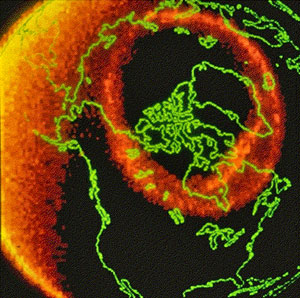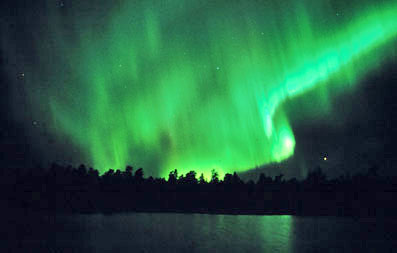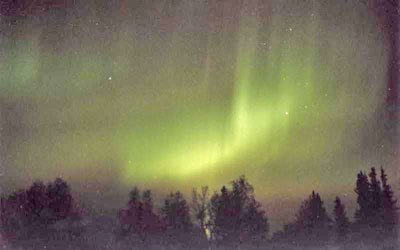|
CHAPTER 10 – THE AURORA
In the polar regions explorers, scientists and the inhabitants are often
treated to phenomenal displays of light darting across the sky. This is the
Aurora Borealis. The aurora is one of natures most beautiful and mysterious
phenomena. Most people have been taught at school that the aurora is the
result of charged particles expelled from the Sun. These particles, racing
through space strike the Earth in the polar regions.
Most of these particles
are expelled by solar flares and various storms on the surface of the Sun.
These charged particles,
|

The photograph above
shows that the light of the aurora forms an oval shape high above
and surrounding Earth's magnetic poles. |
upon striking the Earth’s atmosphere cause the
aurora. Some people are aware that the Earth’s aurora, and that of other
planets (like Jupiter for example) appears as a ring-like structure when
photographed from space.
The aurora used to mystify the early polar explorers. Sir Edmund Halley was
the first to speculate that it might be caused by ‘luminous material’
escaping form his Hollow Earth. This was seized upon by
Hollow Earthers ever since and has become an integral
part of the idea. Marshall Gardner tried to demonstrate that
the aurora was caused by rays of light shining out of
the Hollow Earth.
He thought the aurora might be due to rays from a central Sun
shining out of the Earth. However, we now know so much more about its exact
behavior. Gardner’s idea, as well as Halley’s ideas are
definitely invalid.
I was nevertheless fascinated by the possibility of a nuclear reaction
within the Earth and so I spent several months familiarizing
myself with
the technical detail of the aurora. I wish to call the Reader’s attention to
something much more subtle – to a phenomenon known as the ‘pulsating
aurora’.
Charged Particles From Where?
Scientists state that the charged particles which drive the aurora all come
from the Sun. But is this really so? As a general statement, I have no
problem with the concept that most of the charged particles do indeed
originate from the Sun. Let us say, for the sake of argument, that 90% of
the charged particles which drive the aurora probably emanate from the
Sun.
But as will be seen later, there are some, notably those which cause the
pulsating aurora, which seem to hint strongly at a terrestrial origin. Prof.
Davis writes:
“…these (charged) particles drift outward in the solar wind so
slowly (1000 times slower than the sunlight) that the journey takes several
days. Once the charged particles enter the magnetosphere, they undergo
acceleration to speeds near one-fifth that of the speed of light. They then
are capable of penetrating into the atmosphere to a depth of approximately
100 Km above the Earth’s surface.”
This fact is of crucial importance. The
charged particles which arrive here from the Sun have far too little energy
to actually create the aurora. So how are they accelerated? Scientists don’t
know either.
The Aurora’s Pulse
 The
Sun might well feed some charged particles to the Earth, but the
Earth
somehow controls the aurora. Many mysteries abound which we shall visit. The
pulsating aurora is normally seen after the magnificent auroral break-up. It
pulsates quietly in the night sky for hours on end. The pulsating auroral
forms undergo periodic or semi-periodic variations in brightness. The
periods range from 0.1 sec to more than 20 sec. Prof. Davis writes: The
Sun might well feed some charged particles to the Earth, but the
Earth
somehow controls the aurora. Many mysteries abound which we shall visit. The
pulsating aurora is normally seen after the magnificent auroral break-up. It
pulsates quietly in the night sky for hours on end. The pulsating auroral
forms undergo periodic or semi-periodic variations in brightness. The
periods range from 0.1 sec to more than 20 sec. Prof. Davis writes:
“Pulsating aurora is spectacular, but it lacks the brightness, color and
fast motions typical of the discrete aurora. In the over-all scheme of
things, pulsating aurora is important because it is widespread and therefore
represents the end effect of a substantial portion of the energy carried
into the global auroral atmosphere by incoming fast particles. Some
observations suggest that the ‘on’ phase of a pulse is associated with an
increase in energy of the responsible incoming particles because the
altitude of the lower border during the ‘on’ phase is lower than the
altitude of nearby diffuse non-pulsating background aurora that may
accompany the pulsating forms.”
Inherent in much of the aurora is this
distinctive pulsation, this variation in its strength. Since these discrete
auroras are caused by incoming streams of electrons, the implication is that
something is in control of the incoming streams of electrons. What could be
pumping these electrons into the polar skies – sometimes with a burst-like
structure? The Reader should note that in all the examples given this
flickering pulsating and flaming is taking place in the midnight sector of
the Earth where the Sun has no effect at all.
Due South
There is another pre-condition for auroras which may strike the Reader as
strange and unexpected – the Sun’s magnetic field must point south.
Prof.
Davis explains:
“…the largest magnetic storms and the
greatest auroral
displays occur only when the solar magnetic field points nearly directly
south – and also when the solar wind is moving most rapidly, and when the
strength of the magnetic field at the magnetosphere boundary is at its
strongest. Major auroral displays and major magnetic storms apparently never
occur unless the solar magnetic field at the magnetosphere boundary is
pointed primarily south.”
It is strange that the Sun’s magnetic field must
point in a north-south direction before the particles can enter the Earth’s
magnetic field. Could it be that the Earth’s magnetic field is ‘weakest’ at
a point in line with a possible Polar Hole in the Earth’s crust? Consider
this mystery: The scientists are not quite sure where the charged particles
are entering the magnetosphere – because it repels the charged particles –
98% of them. There has to be some weakness in the magnetosphere
which allows
the particles to enter. They surmise that the particles are entering from
behind the Earth. But what if there is a ‘hole’ in the
magnetosphere? A
‘hole’ which is a direct consequence of a hole in the crust of the planet?
Could this be why the particles must be moving southward before they can
then penetrate the magnetosphere and then cause the aurora?
So the charged particles have entered the magnetosphere. What then? The
following sentence, penned by Davis is very telling:
“What happens there is
not know, but one view is that the kinetic energy carried by the particles
becomes temporarily stored as magnetic energy which then releases suddenly
during substorms and causes the acceleration of auroral primaries.”
It is
clear from the above that some uncertainty exists regarding the sequence of
events once these charged particles enter the Earth’s magnetic field. How
are the ‘stored’? How are they accelerated?
Auroral Conjugacy
Back in 1733 the French scientist Jean Jacques d’Ortous de Mairan thought
that auroras might occur in the southern hemisphere as well. He suspected
that the aurora was caused by the Sun, and he therefore expected the
aurora
to be identical in both hemispheres. The term ‘auroral conjugacy’ is even
more specific. It means that the aurora in one hemisphere is the mirror
image of the aurora in the other hemisphere. Prof. Davis took part in a set
of experiments which as far as I know have never again been repeated. They
devised a computer algorithm to determine the exact conjugate point for a
magnetic line of force originating from Fairbanks, Alaska.
They determined
this point to lie in the Pacific Ocean about 1500 Km south of Christchurch
and 600 Km east of Macquarie Island. To test their ideas they conducted 18
paired flights between 1967 and 1971. They made use of long-range military
versions of the Boeing 707. These aircraft were equipped with various
cameras and sensitive auroral television cameras. One aircraft would take
off from Anchorage, Alaska, while the other would take off from
Christchurch, New Zealand. These two aircraft then flew along carefully
prescribed paths which allowed them to reach the calculated geomagnetic
conjugate points simultaneously. Their routes took them towards the poles
and back to their launching sites.
They discovered that auroral displays in the different hemispheres
were
almost mirror images of each other. This was especially true at the equatorward boundaries of the aurora. They also discovered that
auroras in
the northern hemisphere tended to be brighter than those in the southern
hemisphere. There were some instances of exact conjugates occurring, but
there were also instances where the conjugacy failed altogether. It is
interesting that conjugacy tended to fail at the higher latitudes. The
original idea regarding conjugacy related to the idea that charged particles
from the Sun were striking the Earth’s polar regions simultaneously.
Since
the Sun is almost 100 times the diameter of the Earth, one would expect the
particles from a solar flare to engulf the Earth and for the aurora to be
almost identical at all times. However, as the Reader now understands, this
is not the case. The particles which strike the Earth are possible coming
from ‘above’ (the North or South Poles), and possibly from
behind the Earth.
The brightest aurora is on the night side of the Earth,
away from the direct
line of sight of the Sun. Also, the particles are traveling too slowly when
they reach the Earth. Something is accelerating them. And yet, in spite of
all this manipulation of these particles from the Sun, they retain some form
of conjugacy. But they do more than that. Is something inside the
Earth
controlling the aurora’s behavior?
Prof. Davis discovered:
“The use of television systems on the aircraft led
to one rather startling result. The systems detected pulsating auroras that
were exactly synchronous; that is, the pulsating forms varied in brightness
at exactly the same times in the two hemispheres within a tiny fraction of a
second.”
The pulsations, great and small, match each other in intensity tens
of thousands of miles apart from each other. Remember too that the pulsating
aurora continues for hours and hours, and that these streams of electrons
increase and decrease in intensity for hours on end, across large parts of
the sky. Most amazing of all, in spite of this variability, these pulsations
match each other exactly at opposite ends of the Earth. And where are these
variable amounts of charged particles coming from? Are they all ‘stored’
from the Sun?

The explanation that two ends of a magnetic bottle open up simultaneously,
allowing only some electrons to escape, seems highly improbable to me. It
calls for a system of micro-management of the geomagnetic field at both ends
of the Earth simultaneously. By what means could this occur if the Earth
were solid? But what if these electrons originated from inside the Earth?
What if an Inner Sun produced a variable stream of electrons? And what if an
Inner Sun pulsated in some way?
These streams of electrons might exit the
Polar Holes, follow the magnetic lines of force and cause an
aurora in the
opposite hemisphere. An electron stream originating from Antarctica would
therefore cause an aurora in Alaska for example. These quasi-periodic,
semi-random pulsations might then match in both hemispheres simply because
they come from the same source. They might also match each other in
intensity – more or less.
Traveling at tremendous speed, they would strike
the atmosphere in two hemispheres almost virtually simultaneously. Prof.
Davis confirmed:
“When we were able to detect corresponding
pulsating
auroras in the two hemispheres, they were always exactly in phase, right
down to a few milliseconds… No, we never saw any that were shifted at all.
We really expected to find them bouncing out of phase just like a tennis
ball going across the net and being hit back by racquets on either court,
but that definitely was not the way it was…. Whatever the cause it would
seem that the triggering of the pulses must occur in the equatorial plane.”
But there’s a problem in postulating the equator as the source of the
pulsating aurora. The magnetic field at the equator is approximately half as
strong as in the polar regions – the magnetic field is at maximum strength
in the polar regions and is controlled from there. There is no known
mechanism at the equator which has any effect on the magnetic field.
Remember too that the pulsating aurora occurs at night, and therefore the
Sun cannot be the direct cause of these pulsations.
Let me attempt a Hollow Planet explanation of the Earth’s aurora – and judge
for yourself whether this scenario makes any sense. A solar flare erupts on
the surface of the Sun, sending charged particles racing outwards towards
the planets. Most of the particles are repelled by the Earth’s atmosphere
except for those occasions when the Sun’s magnetic field points southwards.
Only these particles can slip through a weakness or a hole in the Earth’s
magnetosphere. (A hole which has yet to be discovered, I might add.)
These
southward moving particles are then channeled by magnetic lines of force
into a hole in the crust of the Earth. This happens to them because the
Earth’s magnetic field originates from this point. They follow the magnetic
lines of force through the Inner Earth and exit at a south polar entrance.
Under normal circumstances they would continue to encircle the Earth forming
a doughnut-shaped belt which we call the Van Allen belt. Under normal
conditions these particles possibly continue orbiting into and out of the
Earth for days and weeks on end. They are constantly traveling in this
circular motion. Could this be how these particles are gradually
accelerated?
A stream of electrons produced by the Inner Sun might exit the Earth via its
south Polar Hole and then be guided by the magnetic lines of force. These
electrons would then go around the outside of the Earth and enter the Earth
again. In this manner these electrons would continuously circuit the Earth
without there being any indication whatsoever of their presence. There may
be other streams of charged particles which move in the opposite direction
by exiting via the north Polar Hole and entering through the
south Polar
Hole. These two opposing streams of charged particles would be encircling
the Earth in opposite directions – endlessly. This might be the cause of the
Van Allen belt – which surrounds the Earth.
Remember the possible connection between a south pointing solar magnetic
field and auroral storms? Prof. Davis and most other scientists in Europe,
America and Russia are residing in the northern hemisphere. For them it is
probably true that a south pointing solar magnetic field triggers auroral
storms in the northern hemisphere. What if a north pointing solar magnetic
field were the cause of auroral storms in the southern hemisphere? This
seems to me to be a logical conclusion to draw. Hence I’m suggesting that
perhaps there are two opposing streams of charged particles circling the
Earth.
Let’s suppose that these streams continue circling around and through the
Earth for days and weeks on end. Then a ‘magnetic storm’ is triggered by the
Central Sun. The Central Sun may then bend the magnetic lines of force
causing them to now strike the Earth’s atmosphere thereby causing the
aurora
quite a considerable distance away from the polar entrance. As the Central
Sun’s activity intensifies, it perhaps bends the magnetic lines of force
even more so that the auroral oval widens and the aurora moves southwards.
It seems from the evidence that most of the particles do indeed originate
from the Sun. However, there may be a small percentage contributed by a tiny
Central Sun inside the Earth.
The Dynamo Link
The idea that most aspects of the aurora may be linked to events at the core
of a Hollow Planet may well seem absurd, so let me offer some evidence. The
pulsations of the pulsating aurora definitely seems to have an earthly
origin and to be related to whatever ‘dynamo’ it is which creates the
Earth’s magnetic field:
“Pulsating auroras are usually accompanied by
geomagnetic pulsations, and very rarely by faint whistling sounds. They also
appear to generate 3000Mc radio waves.”
Or is it that whatever generates the
3000Mc radio waves also generates the geomagnetic pulses as well as the
pulsating aurora?
It turns out that the night sky pulsates of its own accord. An interesting
study resulted in the discovery of atmospheric brightness pulsations lasting
about one millisecond, consisting of damped oscillations at a frequency of
approximately 10 Kilohertz. These flickers are hard to explain in terms of
terrestrial atmospheric physics. Could it be that the flickers in the night
sky and the pulsations and radiowaves of the
pulsating aurora are all caused
by an Inner Sun?

|

 The
Sun might well feed some charged particles to the Earth, but the
Earth
somehow controls the aurora. Many mysteries abound which we shall visit. The
pulsating aurora is normally seen after the magnificent auroral break-up. It
pulsates quietly in the night sky for hours on end. The pulsating auroral
forms undergo periodic or semi-periodic variations in brightness. The
periods range from 0.1 sec to more than 20 sec. Prof. Davis writes:
The
Sun might well feed some charged particles to the Earth, but the
Earth
somehow controls the aurora. Many mysteries abound which we shall visit. The
pulsating aurora is normally seen after the magnificent auroral break-up. It
pulsates quietly in the night sky for hours on end. The pulsating auroral
forms undergo periodic or semi-periodic variations in brightness. The
periods range from 0.1 sec to more than 20 sec. Prof. Davis writes:
